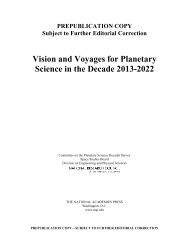Photogeologic Mapping of the Moon - Solar System Exploration
Photogeologic Mapping of the Moon - Solar System Exploration
Photogeologic Mapping of the Moon - Solar System Exploration
You also want an ePaper? Increase the reach of your titles
YUMPU automatically turns print PDFs into web optimized ePapers that Google loves.
To establish age relations and interpret <strong>the</strong> mode <strong>of</strong> formation <strong>of</strong> <strong>the</strong> rock units in <strong>the</strong> area it is best to examine<br />
<strong>the</strong> area in detail. Enlargements <strong>of</strong> Figure 16.6 will be used for this purpose.<br />
Part A<br />
1. Study Figure 16.7 (an enlargement <strong>of</strong> <strong>the</strong> southwest quadrant <strong>of</strong> Figure 16.6) in detail and list observations<br />
and evidence which might establish <strong>the</strong> relative age <strong>of</strong> <strong>the</strong> rugged clusters <strong>of</strong> hills and <strong>the</strong> intervening<br />
smooth regions.<br />
2. List possible reasons why craters are more readily apparent on <strong>the</strong> smooth regions (vs. <strong>the</strong> hills).<br />
3. Indicate your conclusion about <strong>the</strong> relative age <strong>of</strong> <strong>the</strong> two terrains (which is older).<br />
4. List <strong>the</strong> characteristics <strong>of</strong> <strong>the</strong> smooth unit which might bear on its mode <strong>of</strong> formation; suggest a possible<br />
origin(s) for this unit.<br />
5. List <strong>the</strong> characteristics <strong>of</strong> <strong>the</strong> rugged hills and suggest possible origins. Interpretations should be preliminary<br />
pending examination <strong>of</strong> <strong>the</strong> o<strong>the</strong>r quadrant enlargements (see also Figure 16.5).<br />
6. Study Figure 16.8 (an enlargement <strong>of</strong> <strong>the</strong> northwest quadrant <strong>of</strong> Figure 16.6). List any additional characteristics<br />
associated with <strong>the</strong> smooth region which might bear on its mode <strong>of</strong> origin.<br />
7. Briefly describe <strong>the</strong> several clusters <strong>of</strong> craters visible in Figure 16.8. What is <strong>the</strong>ir age in relation to <strong>the</strong><br />
smooth region?<br />
8. Propose a tentative mode <strong>of</strong> origin for <strong>the</strong>se crater clusters, including any possible directional information.<br />
9. Study Figure 16.9 (an enlargement <strong>of</strong> <strong>the</strong> nor<strong>the</strong>ast quadrant <strong>of</strong> Figure 16.6). Briefly describe <strong>the</strong> various<br />
characteristics <strong>of</strong> <strong>the</strong> topography surrounding and associated with <strong>the</strong> crater Euler.<br />
10. Propose an origin for <strong>the</strong> topography <strong>of</strong> <strong>the</strong> material at crater Euler.<br />
11. Study <strong>the</strong> outer boundary <strong>of</strong> <strong>the</strong> unit which includes Euler and its associated crater materials (recall<br />
Figure 16.3). Using Figures 16.6, 16.7, 16.8, 16.9, 16.10 measure and record <strong>the</strong> distance from <strong>the</strong> rim<br />
crest <strong>of</strong> Euler to <strong>the</strong> outer boundary <strong>of</strong> <strong>the</strong> crater materials in a NW, NE, SE, and SW direction.<br />
Exercise Sixteen:<br />
<strong>Photogeologic</strong> <strong>Mapping</strong> <strong>of</strong> <strong>the</strong> <strong>Moon</strong><br />
201<br />
EG-1998-03-109-HQ Activities in Planetary Geology for <strong>the</strong> Physical and Earth Sciences











